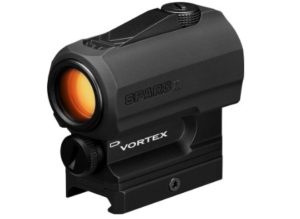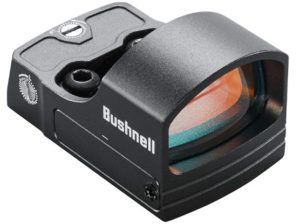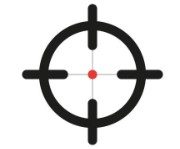Reflex Sight vs Red Dot. Are you wondering what the main difference between red dots and reflex sights is? In this article, we will look at the features, pros, and cons of red dots and reflex sights. Read on as we will share the main differences and highlight other types of red dots.
If you own a firearm for hunting or target shooting, you have probably used a reflex sight or red dot to hone your accuracy skills. These sights are designed to help improve accuracy and speed up target acquisition.
However, these types of sights have distinct differences that make them suitable for different shooting applications. They also have some similarities when it comes to close-range shooting applications.
By the end of this post, you will know the features, advantages, and disadvantages to help you determine which is best for you.
Before we start it is important to note that every reflex sight is a red dot sight but not every red dot sight is a reflex sight. Sounds confusing but you’ll get it better as you continue reading.
Let us get right into it.
What is a Red Dot Sight?

A red dot sight is a non-magnifying sight that uses red dot reticle technology to improve accuracy and speed up target acquisition. The red dot is illuminated by an LED light, allowing you to use it even in low-lighting conditions.
All you need to do is to look through the lens and align the dot with the target. It is almost similar to using iron sights.
One of the main advantages of red dots is that they allow for quick and easy target acquisition. In addition, they are designed for both close and long-range shooting applications.
It is worth mentioning that some sights use a green dot or an illuminated electronic image to provide an aiming point.
Let us look at the pros and cons of red dots.
Pros
- They are designed for quick target acquisition.
- They are suitable for fast-paced shooting scenarios, such as hunting, self-defense, or tactical situations.
- They are ideal for both close and long-range shooting applications.
- They are compatible with firearms, such as rifles, shotguns, and handguns for hunting, target, and tactical shooting.
- They are designed with durable housing to ensure they are shock-proof, fog-proof, and waterproof.
- They can withstand the recoil of most firearms.
- They fit the budget of most shooters, making them ideal for shooters who want an affordable option.
- They consume less power and last long hours, making them ideal for shooting and hunting trips.
- They are very easy to use, even for novice users.
Cons
- Red dot sights rely on batteries to function and don’t work if the battery is dead.
- They are more expensive than traditional sights.
- They have parallax, which can cause issues when shooting targets at long ranges.
What is a Reflex Sight?

A reflex sight is a non-magnifying sight that uses a red or green dot projected onto a transparent lens. Reflex sights are one of the main types of red dot sights.
They are called “reflex sights” because a small light is projected from the scope’s rear. The front lens reflects as a red dot, allowing you to aim at any target. All you need to do is look through the lens and align the dot with the target.
Reflex sights are popular because they allow for quick and easy target acquisition. They are also ideal for both close to long-range shooting applications.
It is important to note that there are two types of reflex sights. They are tube sights and exposed reflex sights.
Exposed reflex sights have a single lens positioned at the front of the scope. The lens reflects the dot, making it easy to aim at different targets. Reflex sights have unlimited eye relief. They have unlimited eye relief making them suitable for hunting, self-defense, and tactical shooting applications.
On the other hand, tube reflex sights have two lenses. They look like traditional small scopes and have unlimited eye relief. The light is projected from the rear lens and reflected by the front lens.
However, reflex sights are not quite as fast as exposed reflex sights when it comes to target acquisition. We recommend them for shooters who prefer a more traditional and durable sight for close-range shooting applications.
Let us look at the pros and cons of reflex sights.
Pros
- They are designed for quick target acquisition because you do not have to align the sight with the target, making them ideal for tactical shooting applications.
- They are ideal for hunting, target shooting, and tactical shooting.
- They are compatible with rifles, shotguns, and handguns.
- They are constructed with durable housing to make them shock-proof, fog-proof, and waterproof.
- They have a large field of view, making it easy to see clearly, especially in low-lighting conditions.
- They have a wide range of adjustability, allowing you to improve accuracy.
- They are available in multiple reticle options.
- Some reflex sights have night vision compatibility, allowing you to hunt in low-lighting conditions.
Cons
- Reflex sights are more expensive than red dots because they have advanced technology to improve accuracy.
- They are heavier than red dots
- They are not ideal for harsh conditions.
Main Differences between Red Dots and Reflex Sights
Red dots and reflex sights have similar benefits but have key differences. Here are some of the main differences:
- The main difference between red dots and reflex sights is the reticle. Reflex sights have different reticles like a dot, crosshair or ring. On the other hand, red dots have a single dot reticle.
- Reflex sights offer a larger field of view compared to red dot sights. A larger field of view makes it easy to see more of the target, especially in low-lighting situations.
- Reflex sights have different adjustability options than red dots. This makes them ideal for long-range shooting applications because they are more accurate.
- Reflex sights are more expensive than red dots.
- Red dots have a more robust housing than reflex sights.
- Red dot sights have a longer battery life compared to reflex sights.
Red dots and reflex sights are very popular because they improve shooting accuracy and target acquisition. However, it is important first to define your requirements to make the selection process easy.
Conclusion
In this Reflex Sight vs Red Dot post, we have shared the important features, pros, and cons of red dots and reflex sights. As you have seen, they have some similarities, like quick target acquisition, compatibility, and durability. However, they have some major key differences when it comes to the reticle, field of view, cost, and battery life.
Before selecting a red dot or reflex sight, it is advisable first to define your shooting requirements. This will make it easy to choose a proper sight to improve your accuracy skills.
Now that you have known the major differences between red dots and reflex sights select the right sight for your rifle, shotgun, or handgun.
You May Also Like: 7 Best Red Dots for 9mm Rifle

